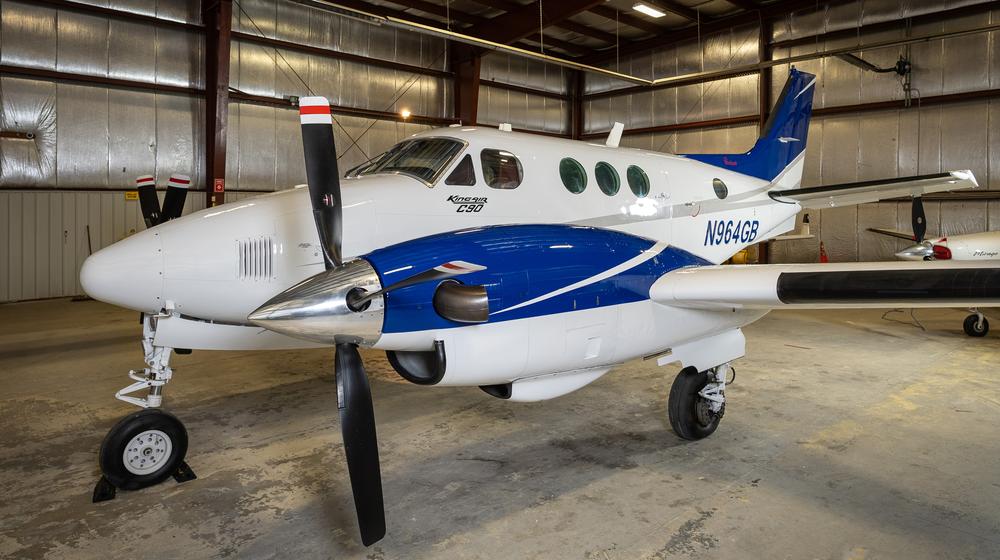A Classic Turboprop, Refined for the Modern Era: N964GB

Current Ask: $859,000 | Learn more at www.N964GB.com
Few aircraft balance performance, comfort, and reliability like Beechcraft’s King Air C90. Built in 1982, N964GB carries on that tradition with modern avionics, meticulous Part 135 charter maintenance, and a fresh 2024 exterior repaint. Whether you need a dependable workhorse for business travel, a personal aircraft for regional hops, or a sturdy platform for special missions, N964GB delivers.
Pratt & Whitney PT6A-21 engines power this proven airframe, providing the reliable thrust and range the King Air series is known for. Inside, six plush seats and refined finishes ensure every flight—from short hops to multi-leg trips—is both comfortable and productive.
The Evolution of the King Air C90
Introduced in 1971, the C90 refined the original King Air 90 with a higher gross weight, improved pressurization, and aerodynamic tweaks. It quickly became a standout in the King Air family, praised for its versatile range, short-field performance, and roomy cabin. Over decades of continuous upgrades, the C90 remains a top turboprop, prized for its reliable Pratt & Whitney PT6A-21 engines and rugged build.
The Performance and Power of N964GB
Equipped with dual PT6A-21 engines producing 550 shaft horsepower each, N964GB cruises around 240 knots with a range of approximately 1,260 nautical miles. Recent hot section inspections keep these engines operating at peak efficiency, and a gross weight increase modification ensures added payload flexibility. Whether hauling colleagues, family, or cargo, you’ll appreciate the King Air’s rock-solid performance.
Key Specs:
Engines: Pratt & Whitney PT6A-21 (550 SHP each)
Cruise Speed: ~240 knots
Range: ~1,260 nautical miles
Takeoff Distance: ~1,984 feet
Gross Weight Increase: Boosted payload capacity
Avionics: A Glass Cockpit with Cutting-Edge Technology
You step into the cockpit and settle into the left seat, greeted by a modern suite anchored by dual Garmin G600 displays and a Garmin GFC600 autopilot. The G600’s synthetic vision offers a crisp, three-dimensional terrain view, while the autopilot smoothly manages flight profiles from climb-out to approach. Just to your right, a Garmin GTN 750 touchscreen serves as your primary navigator, with a GTN 650 below for backup and additional functionality.
A new GI275 display provides even more redundancy—offering backup flight data or engine information in a compact, high-resolution format. As you scroll through the GTN 750, plugging in departure and arrival procedures, the flight plan syncs seamlessly across all displays. You can see real-time airport diagrams on the screen with Garmin’s SafeTaxi®, ensuring you won’t miss a turn on the ground.
Once the engines spool up with their characteristic PT6 whine and you advance the condition levers, the hum settles into a reassuring rhythm. Taxi is straightforward with the G600’s PFD/MFD combination and the GTN 750 guiding you through every intersection. Before takeoff, the Bendix/King RDR 2000 weather radar confirms favorable conditions, while dual Garmin GTX 330 ES transponders broadcast your ADS-B Out signal.
Lined up on the runway, you smoothly push the power levers forward. The takeoff roll is confident and brisk; at rotation speed, a gentle pull lifts you into the sky. Engaging the GFC600 autopilot for the climb reduces workload, letting you focus on monitoring systems and situational awareness. The Avidyne EX600 MFD overlays traffic and weather in real time, so you can make smart routing decisions early.
In cruise, the FlightStream 510 wireless gateway connects your tablet to the avionics, making flight-plan tweaks and approach updates effortless. As you descend toward your destination, the GTN 750 and GTN 650 load approach charts directly onto the G600 display. The GFC600’s smooth control inputs ensure a stable glide path, and when you break through the clouds, transitioning to manual flight feels natural and predictable.
From takeoff to touchdown, the avionics in N964GB work with you, reducing pilot workload and enhancing situational awareness. It’s more than just technology—it’s a co-pilot you can rely on in every phase of flight.
Stepping into Comfort: The Passenger Experience
Moving into the cabin, the engine noise gives way to a gentle hum, thanks to robust insulation and pressurization. Six leather-upholstered seats offer generous legroom and recline, complemented by large windows that flood the interior with natural light. Modern climate control keeps conditions pleasant year-round, and built-in power ports handle laptops, tablets, or headsets with ease. Whether you’re holding a quick meeting or simply enjoying the view, the C90 cabin underscores why it’s a standout in the turboprop class.
The Advantage of Part 135 Maintenance: Hassle-Free Ownership
Maintained under FAA Part 135 charter rules, N964GB undergoes:
Stricter Inspection Schedules – Components meet more rigorous commercial standards.
Frequent Maintenance Checks – Reduces the risk of unexpected downtime.
Higher Operational Oversight – Ensures thorough compliance with manufacturer and FAA directives.
This means you step into an aircraft that’s ready to fly—no guessing if essential service was deferred. Every system, from engines to avionics, has been maintained to commercial standards, freeing you to focus on flying instead of lingering maintenance tasks.
Why N964GB Stands Out
Modernized Avionics – Garmin G600 displays, GTN 750/650 navigators, GI275 backup display, and GFC600 autopilot
PT6A-21 Engines – Recent hot sections for peak performance
Gross Weight Increase – Expanded mission and payload flexibility
Part 135 Maintenance – Top-tier reliability and oversight
Fresh 2024 Paint – A pristine, modern exterior
Well-Appointed Interior – Comfortable, passenger-friendly cabin